
Vichy
I can’t tell if the waters of Vichy matter more than the memories.
I put a photo from what we would call the Edwardian era, which in France was the Belle Époque, because that may have been the last time that this place made sense. In the Second Empire, Napoléon III (the original’s nephew) commenced a huge development to turn Vichy into a premiere spa town. The Industrial Revolution had given them iron and machine-made decorations, and later, electricity, so most of the buildings here are from Victorian and Edwardian times. This makes for nice housing stock, but in spite of several desultory efforts to renovate the spa constructions, e.g. the springs themselves and the huge Moorish style thermal baths, they are in a pretty moribund state. A large chunk of the park in the middle was a construction site as well, so it isn’t for lack of trying that they haven’t succeeded in making this a premiere destination resort. It feels like each effort lapsed into apathy. It was listed as a UNESCO World Heritage site in 2021, so maybe that is fueling the most recent hopes. 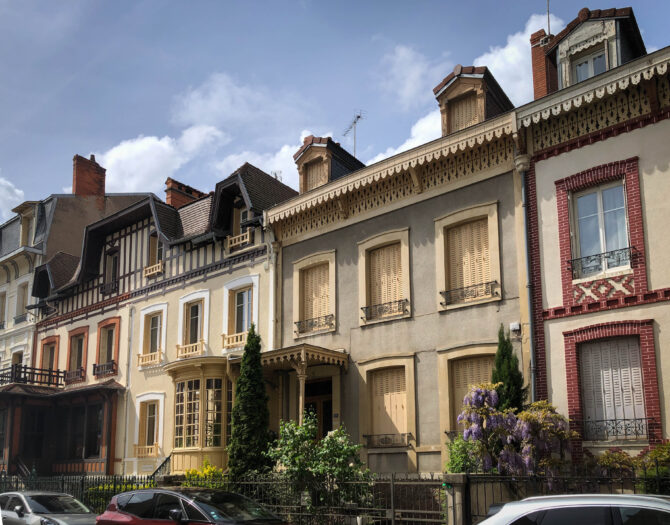
After doing my laundry in the morning, I spent the day walking a long circuit around the old health and entertainment sites, including many lovely streets of fanciful homes. All kinds of architectural styles were revived, and for some reason a sort of Swiss chalet style, is it?, caught the fancy of The Emperor himself, and his wife. Next to the park fronting the Allier river, they built themselves “his and her” houses. Then everyone copied them, in this part of town.
‘His’ was strong and manly brick (note the N on the front doors).
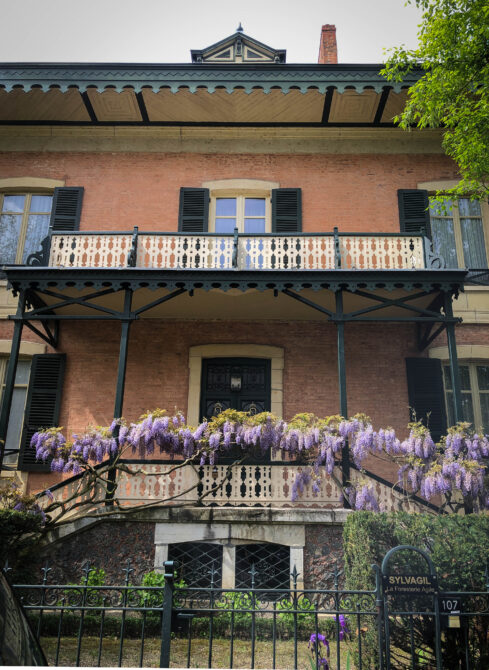
“Hers” is light and airy, and above the door it says “Empress Joséphine” in nice cursive script.
I read there are actually 12 different mineral springs in the environs of Vichy, some hot, some cold. Some you drink for your health, and others you soak in. There are still a couple of full-service spas, in modern architecture, with doctors and massage and physical therapists keeping offices there. They honestly don’t look very upscale, to say the least.
In the main Salle des Sources, or hall of the springs, there are quite a few different springs on tap, although you have to actually have a prescription to partake of most of them. They also have no cups available, and there are signs saying it is ‘forbidden’ to drink directly out of the taps. So very French. I’ll show you what it looks like now. Inside here there are also a couple of the springs themselves, surrounded by concrete holes and covered in strange looking glass housings, similar to the one below.
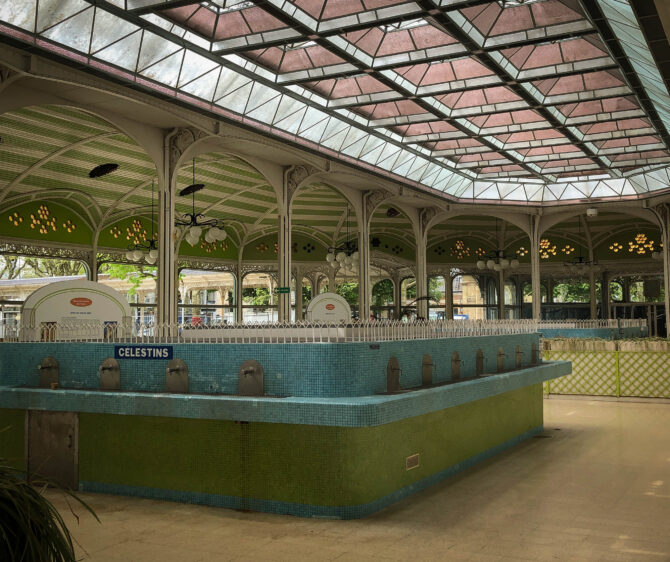
Probably during the late 1980s, they decided to update a bit, and illustrated the effects this water has on the well being of people. 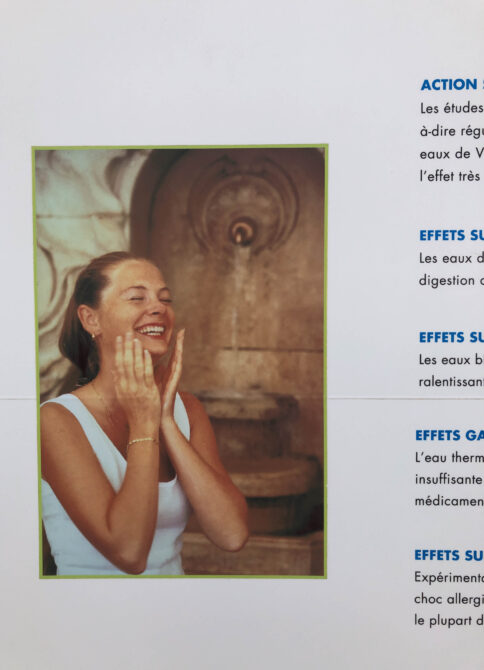
Next, I went over to the Palais de Congrès, but it was being used for a private convention. Something about making the world a better place through private training and education. Sounds like skullduggery to me. Anyway, the famous Opéra is right next door, and that I could go into. This is the place where the French government, who chose not to fight the Germans in WWII, elected the respected WWI officer Marshal Pétain as their leader. I read that they did not fight the Allies in France, but when the Allies invaded France’s colonies in North Africa, French forces did fight them. They also helped round up about 76,000 Jews to go to internment camps.
 The Opéra also has seen better days, and has signs of deferred maintenance, even though they spent a great deal of money renovating it a few decades ago. It’s all very puzzling. I saw that a couple of months ago one of my favorite French actresses from a Netflix series I liked did a one woman show here a couple of months ago, based on a book by a young German woman, about being a German woman who wants to be a man with a “Jewish Cock,” (the name of the book in English) to help her atone for the Nazi crimes fifty years before she was born. I just cannot get enough of WWII references in my cultural diet, can you?
The Opéra also has seen better days, and has signs of deferred maintenance, even though they spent a great deal of money renovating it a few decades ago. It’s all very puzzling. I saw that a couple of months ago one of my favorite French actresses from a Netflix series I liked did a one woman show here a couple of months ago, based on a book by a young German woman, about being a German woman who wants to be a man with a “Jewish Cock,” (the name of the book in English) to help her atone for the Nazi crimes fifty years before she was born. I just cannot get enough of WWII references in my cultural diet, can you?
And for one more, I stumbled upon a square with an enormous sculpture, topped with a very manly man dangling a sword from his right hand. It is a WWII memorial, rather than the usual, safe, WWI memorials found in all French towns. I saw that it had been modified, and went closer for a look. The original says “The town of Vichy, to her children who died for France. 1939-1945”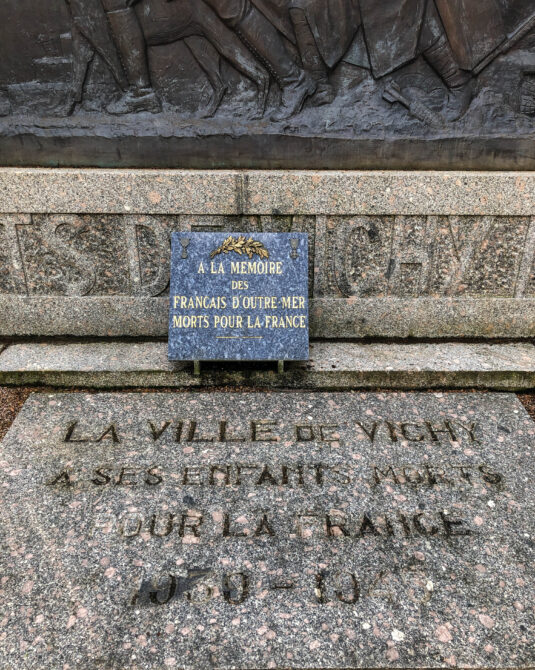
Yes, this means died defending Vichy France against the British and Americans, in North Africa. I’ve never seen a monument to this. However, somebody did insist on revising the memorial.
The little addition says “To the memory of the overseas French who died for France.” But the first was not removed. It makes me wonder what feelings still swirl in the people down here, away from Paris.
Eventually, down the river a bit, I came upon the spring which is the actual Source des Célestins. The Celestines were the monks who first made this a place for cures, and later attracted the famous Madame de Sévigny, who came in the 1600s because she must have had indigestion. I love her letters, which have been published in a compilation. She is the only French writer I can say I love, and I paid homage at a small bust of her in the park.
Then I went up to taste the Célestin waters. The folks of the Industrial Revolution sure liked decorating stuff, and made spaces that don’t make sense anymore. People had nothing to do but stand or sit around looking at each other, it seems, and this spring has embellished sitting areas on each side that nobody uses.

I went in, and of course there were no cups. There was a man there, chemically testing the waters every so often, and I explained to him that nowhere was I informed that one had to bring their own cup or bottle. He just shrugged his shoulders and said “Use your hands.” I tried it, and it wasn’t bad. Very slightly salty, and slightly fizzy. 
I decided to see if I could find it for sale in a store, in hopes it would help my stomach, which has been delicate of late.
That was a challenge, because the cute boutiques only sell Vichy pastilles, little mints with the local minerals in them.
Finally someone said go down the street to the Monoprix, they should have it. Down a pleasant but narrow street, the Monoprix was barely visible. Opening the door, I saw it was like a mini Target, with clothes on the ground floor, and groceries on the second floor. I found Vichy water in your basic plastic bottle, and bought a liter of it. I finished it off last night, and did feel my digestion rumble and pick up the pace a bit. I failed to find the ecstasy of our lovely française from the 1980s, but it wasn’t bad.

